AMD unveils its upcoming 7nm CPUs and GPUs during Computex keynote
"This is what technology leadership is all about."
Watch the full AMD Computex 2019 keynote above.
AMD has been making waves this year talking about 7nm and its upcoming third generation Ryzen 3000 'Zen 2' CPUs and Radeon 'Navi' GPUs, likely to vie for the crown of best graphics card and best CPU for gaming and primed to slot into the best AMD motherboards. We've known these were coming for a while, but Computex 2019 is where we'll finally get our first true taste of what AMD has to offer. By being the first PC components to utilize TSMC's 7nm node, AMD is taking a bit of a risk, but if things go well this could catapult AMD into the lead.
AMD kicked off the keynote by talking about supercomputers. Building off the Zen 2 and Navi architectures, AMD is working to build the Frontier supercomputer with over 1.5 Exaflops of compute performance by 2021. That's a massive jump from today's current top supercomputers, where Summit tops the list with 'only' 143.5 Petaflops. How will AMD get ten times that performance? Not surprisingly, the answer is 7nm Zen 2 and Navi parts.
AMD already has Epyc 'Rome' CPUs with 64 cores and 128 threads per socket, and using 11,500 such CPUs running in Azure Cloud it's already setting performance records. AMD showed a short comparison of Rome going against Intel's Cascade Lake (56-core/112-thread) in a molecular dynamics simulation, with AMD's CPU roughly doubling the performance of Intel's chip. If these initial results are anything to go by, 2019 will be a big year for AMD.
But let's start with the graphics cards.
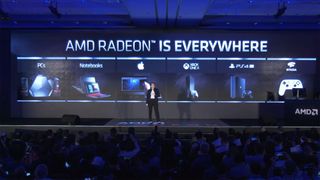
AMD Radeon Navi
AMD says 400 million gamers are already using Radeon graphics. That's a big number, though AMD includes both Xbox One and PlayStation 4 as part of that figure (plus Apple MacBooks and the upcoming Google Stadia). Combined, the two major consoles represent about half to three quarters of that figure, leaving roughly 100-150 million for PC. Not surprisingly, the next-generation PlayStation will be using Navi graphics with a Zen 2 CPU, but Navi is going to be much more than a console solution.
What makes Navi so special? First, GCN is officially out, with a new RDNA (Radeon DNA) architecture replacing it. AMD has been using GCN derived architectures since early 2012, starting with the HD 7970 and related products. Everything AMD GPU since then has been built off the GCN design, but RDNA breaks that with a new compute unit design.
The biggest gaming news, reviews and hardware deals
Keep up to date with the most important stories and the best deals, as picked by the PC Gamer team.
We don't know all the details yet, but the new CU will drive more instructions per clock, higher clockspeeds, and an improved cache hierarchy. Together, all of these give the first generation RDNA compute units a 1.25X performance per clock increase compared to the latest GCN (Vega architecture) GPUs. Paired with higher clockspeeds, AMD says it's Navi products are delivering 1.5X more performance than the equivalent GCN products.
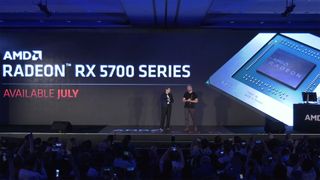
Let's talk names, though—officially, AMD is revealing the Navi naming as RX 5000 (note: this is a shout out to AMD’s 50th anniversary). It showed a Navi RX 5700 beating an Nvidia RTX 2070 by about 10 percent in the Strange Brigade benchmark. That's apparently at 2560x1440 if you're wondering.
Let me put that performance in perspective: using the same Strange Brigade benchmark, it's one of the few games I tested where a Radeon VII can clearly beat an RTX 2080, by up to 27 percent at 4K, and 9-12 percent at 1080p/1440p. It's just one benchmark, and obviously one where AMD already held an advantage, but the RX 5700 will presumably cost far less than the RTX 2070. We'll have more to say on Navi performance once it launches.
We don't know any other product names officially, but unofficially we expect an RX 5800 with up to 64 CUs based off a fully enabled Navi 10 GPU. There should also be a budget RX 5600, using a Navi 12 GPU that has fewer cores—somewhere in the 24-32 CU range most likely. These will fill out the midrange and budget GPU markets for AMD.
That's it for Navi right now. It's coming in July, as the RX 5000 series initially. (So much for those Radeon RX 3000 leaks, eh?) AMD had Asus and Acer on stage to talk about upcoming Navi and Zen 2 PCs and products, and we've covered some of that news already, but let's move on.
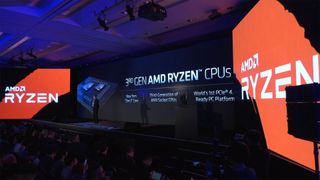
AMD third gen Ryzen and Zen 2
I wouldn't even consider third gen Ryzen a poorly kept secret, considering how much information AMD has discussed previously. Let's start with some of the major changes before we get to the specific models.
The Zen 2 architecture is a significant update to the previous Zen and Zen+ designs. First up, it has double the floating point performance per core compared to the previous generation Ryzen CPUs. It's not clear if AMD is specifically talking about AVX support here, as previous Ryzen CPUs have supported AVX2 instructions but required two cycles per instruction — so AMD could have doubled performance by doing one cycle per instruction. That seems the most likely, and while this won't necessarily help with all workloads, anything that uses AVX/AVX2 should see a healthy uplift in performance.
Next, cache sizes have doubled, which in turn reduces memory latencies and improves performance — AMD specifically mentions improved gaming performance thanks to the larger caches. We'll get into the numbers below, but the 8-core/16-thread Zen 2 chiplet includes 36MB of total cache, broken down into 32MB of shared L3 cache and 512KB L2 cache per core. In other words, it's the L3 cache size that has been doubled.
And finally, there's IPC (Instructions Per Clock). AMD's engineers originally hoped to deliver an 8-10 percent increase in IPC relative to Zen+, which is a decent gain, but the final Zen 2 architecture is set to deliver an average 15 percent increase in IPC. Note that this affects performance in every application, and at the same clockspeed Zen 2 will be about 15 percent faster than Zen+. Intel, for reference, usually gets about a 5-10 percent increase in IPC for each architectural update (note that Skylake, Kaby Lake, and Coffee Lake are technically not an architecture update in the traditional sense), so 15 percent will be a substantial increase.
Outside of the core CPU architecture, Zen 2 has some other additions, including PCIe 4.0 support. This effectively doubles the bandwidth between the CPU and chipset, as well as CPU and peripherals like the graphics card. Normally this isn't a huge bottleneck (we've done benchmarks with PCIe 2.0 connections using newer graphics cards, and for games it's maybe a few percent in most cases), but in certain workloads—anything that overflows GPU memory and starts pulling a lot of data directly over the PCIe bus—it could yield larger performance gains. AMD showed a new 3DMark test that's designed specifically to stress PCIe bandwidth and the Ryzen 7 3800X CPU with a Navi RX 5700 GPU was beating an Intel i9-9900K with RTX RTX 2080 Ti by around 75 percent.
That leads into the first three revealed Zen 2 / third gen Ryzen CPUs. As with Navi, we didn't know any hard, detailed specs until now.
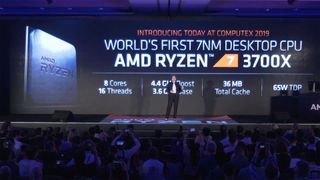
Starting with the Ryzen 7 3700X, it will feature an 8-core/16-thread design, 3.6GHz base clock and 4.4GHz boost clock, and 36MB total cache size … all in a 65W TDP. AMD provided a performance comparison between the 3700X and an i7-9700K running Cinebench R20, with the AMD CPU beating Intel by around 30 percent. The Ryzen 7 3700X isn't the only upcoming third gen Ryzen, but it will be one of the better options in terms of balancing price and performance.
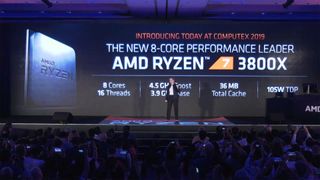
Next up is the Ryzen 7 3800X. Most of the specs are the same as the 3700X, just slightly improved clockspeeds: 3.9GHz base clock and 4.5GHz boost clock, still with 36MB total cache. This time, however, the TDP is 105W—a big jump for the extra 100MHz in boost clockspeed, but the 3800X will hit higher clocks most of the time. But perhaps more interesting than the raw specs, AMD cited some performance figures in games relative to the Ryzen 7 2700X.
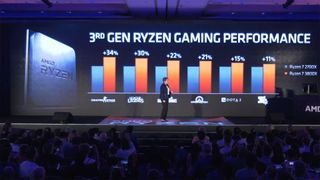
Across a limited selection of games, AMD is showing gaming performance that's anywhere from 11 percent to 34 percent faster than the previous generation. We don't know the GPU or settings used in testing, but I've seen AMD gaming performance at 1080p ultra with an RTX 2080 trail Intel performance by similar margins. What that means is the combination of more cache and architectural improvements could definitely close the gap between AMD and Intel.

And we're not done. AMD announced one more member of the Ryzen 3000 family, the Ryzen 9 3900X. Using two Zen 2 chiplets, AMD provides a 12-core/24-thread CPU with a base clock of 3.8GHz, boost clock of 4.6GHz, 70MB of total cache (!). And it's all still in a 105W TDP form factor. Performance was compared with Intel's Core i9-9920X, also a 12-core/24-thread CPU, and in a Blender rendering faceoff the AMD system was about 18 percent faster, while using less power.
One thing to note is what AMD didn't reveal during the keynote, and that's a 16-core/32-thread processor. Considering the 105W TDP and the dual chiplet design of the 3900X, obviously AMD can release a 16-core part. I anticipate something like a 130W TDP 16-core/32-thread Ryzen 9 3950X will likely be revealed in the coming days, and it will probably have tighter motherboard requirements than the other third gen parts. Specifically, I expect such a part won't be validated to work on some of the lower spec B350 motherboards, but hopefully most X370 and X470 (and all X570) motherboards will have no trouble with such a CPU.
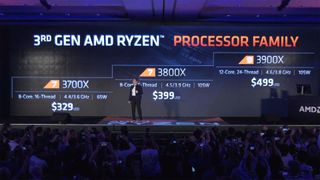
That's it for the new CPUs and AMD's keynote. There are certainly many questions remaining, like other members of the CPU and GPU families. More important is the question of price and release date. As expected, AMD will officially launch both Ryzen 3000 and Navi RX 5000 products on July 7, 2019. AMD didn't give prices for Navi yet, but the 3700X will come in at $329, the 3800X at $399, and the Ryzen 9 3900X will cost $499.
AMD also revealed details for two Ryzen 5 CPUs, the 3600X (6-core/12-thread, 3.8-4.4GHz, 35MB cache, 95W TDP, $249) and the 3600 (6-core/12-thread, 3.6-4.2GHz, 35MB cache, 65W TDP, $199). Those hoping for extremely low prices on AMD's next generation CPUs are likely to be a bit disappointed, with $199 being the lowest price right now. However, keep in mind the performance of that part could end up being comparable to the i7-8700K, maybe even a bit faster.
AMD will also have X570 motherboards out in force at Computex. There are already 57 separate designs from all the major motherboard companies. X570 will be the top tier chipset, with full PCIe 4.0 support and 40 total lanes between the CPU and chipset. Assuming it's like the current AM4 platform, that will be 20 lanes from the CPU (plus four to link to the chipset) and 20 more from the chipset.
We'll be keeping an eye out for both RX 5000 and Ryzen 3000 at Computex 2019 and E3, so stay tuned for more details.
Jarred's love of computers dates back to the dark ages when his dad brought home a DOS 2.3 PC and he left his C-64 behind. He eventually built his first custom PC in 1990 with a 286 12MHz, only to discover it was already woefully outdated when Wing Commander was released a few months later. He holds a BS in Computer Science from Brigham Young University and has been working as a tech journalist since 2004, writing for AnandTech, Maximum PC, and PC Gamer. From the first S3 Virge '3D decelerators' to today's GPUs, Jarred keeps up with all the latest graphics trends and is the one to ask about game performance.
Most Popular






